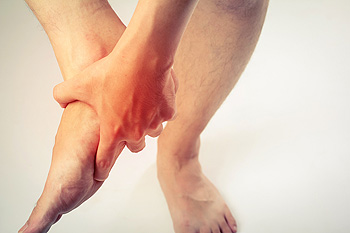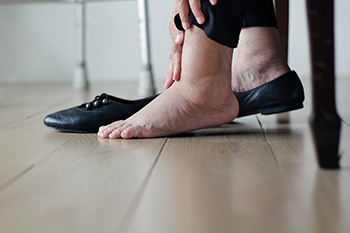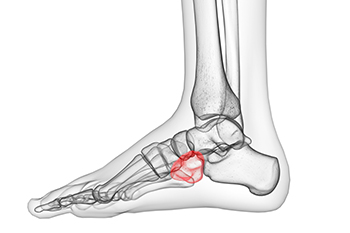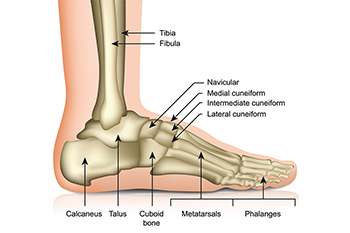Connect With Us
Blog
Items filtered by date: August 2022
Understanding Navicular Stress Fractures

The navicular bone is one of the 26 bones in the foot and is located across the inside top of the foot just in front of the ankle joint. The navicular connects the ankle to the foot bones and helps to form the arch that enables you to walk. Navicular stress fractures, which are hairline cracks in the bone, are often sustained by athletes who kick, twist or sprint. The result is often a chronic midfoot ache, but the vague location of the pain may make it difficult to diagnose. Hopping or standing on tiptoe can be one way of recognizing a navicular stress fracture. Someone with extremely high arches or a longer second toe may be more likely to sustain this injury, experts believe. X-rays may not be able to recognize navicular stress fractures, but an MRI or other imaging test can be more successful. Treatment may involve staying off the foot and wearing a cast for up to six weeks, or longer. If midfoot pain is becoming a nuisance, please consult with a podiatrist for a complete exam, diagnosis and options for treatment.
Activities where too much pressure is put on the feet can cause stress fractures. To learn more, contact Dr. Rouder from S.I. Podiatry. Our doctor can provide the care you need to keep your pain free and on your feet.
Dealing with Stress Fractures of the Foot and Ankle
Stress fractures occur in the foot and ankle when muscles in these areas weaken from too much or too little use. The feet and ankles then lose support when walking or running from the impact of the ground. Since there is no protection, the bones receive the full impact of each step. Stress on the feet can cause cracks to form in the bones, thus creating stress fractures.
What Are Stress Fractures?
Stress fractures occur frequently in individuals whose daily activities cause great impact on the feet and ankles. Stress factors are most common among:
- Runners
- People affected with Osteoporosis
- Tennis or basketball players
- Gymnasts
- High impact workouts
Symptoms
Pain from the fractures occur in the area of the fractures and can be constant or intermittent. It will often cause sharp or dull pain with swelling and tenderness. Engaging in any kind of activity which involves high impact will aggravate pain.
If you have any questions please feel free to contact our office located in Staten Island, NY . We offer the newest diagnostic and treatment technologies for all your foot and ankle needs.
Managing Swollen Ankles and Feet

Swelling around the ankles is nothing to ignore. When one’s ankles become swollen, one can feel tight and restricted, making it significantly difficult to walk and wear shoes that would otherwise fit comfortably. Swelling can occur for any number of reasons. Commonly, pregnancy can make one’s feet swell because of the extra blood and fluids that a pregnant woman produces to support the growing baby. Additionally, your feet and ankles may swell in response to some kind of injury to your feet, ankles, or lower legs. Whatever the cause of your swollen ankles, there are a variety of steps that you might consider taking to mitigate the effects of your swollen ankles. Perhaps you might benefit from wearing compression socks or stockings. These stockings are made to put pressure on your feet, which has the effect of facilitating blood circulation and discouraging fluid from gathering in the feet. Besides wearing compression socks, you might also consider washing your feet and ankles in Epsom salts. This is done to increase magnesium levels, which can have the effect of minimizing inflammation. Lastly, a very common technique that is used to mitigate swollen feet and ankles is to elevate the feet to promote circulation. If you are concerned about your swollen feet, consider reaching out to a podiatrist.
Swollen feet can be a sign of an underlying condition. If you have any concerns, contact Dr. Rouder of S.I. Podiatry. Our doctor can provide the care you need to keep you pain-free and on your feet.
Swollen feet are a common ailment among pregnant women and people who stand or sit for extended periods. Aging may increase the possibility of swollen feet and patients who are obese often notice when their feet are swelling too. There may be medical reasons why swollen feet occur:
- Phlebitis - A condition that causes the veins to become inflamed and can also cause leg pain.
- Liver disease - This may lead to low blood levels of albumin which is a protein. This can cause fluid in the blood to pass into the tissues and several areas of the body can become swollen.
- Heart failure - When the heart doesn’t pump properly the blood that is normally pumped back to the heart can pool in the veins of the legs causing swollen feet.
- Kidney disease - One of the main functions of the kidneys is releasing excess fluid in the body. This type of condition can make it difficult for the kidneys to function properly, and as a result the feet may become swollen.
- Deep-vein thrombosis (DVT)- This is a serious condition where blood clots form in the veins of the legs. They can block the return of blood from the legs to the heart which may cause the feet to swell. It is important to be treated by a podiatrist if this condition is present.
Swollen feet can also be caused by bone and tendon conditions, including fractures, arthritis, and tendinitis. Additionally, there may be skin and toenail conditions and an infection may cause the feet to swell. Patients who take medicine to treat high blood pressure may be prone to getting swollen feet.
Many patients elevate their feet to help relieve the swelling and this is generally a temporary remedy. When a podiatrist is consulted the reason behind the swelling can be uncovered and subsequently treated.
If you have any questions please feel free to contact our office located in Staten Island, NY . We offer the newest diagnostic tools and technology to treat your foot and ankle needs.
What Causes Compartment Syndrome?

Compartment syndrome is a serious condition that can affect the overall health of your foot. A group of muscles, along with nerves and blood vessels, is contained in a band of tissue called a compartment. The fascia around the muscles does not expand, so if it sustains an injury it may bleed or swell. This causes pressure to build up, which cuts off the blood supply of nutrients and oxygen to the muscle. Muscles can become permanently damaged if not treated quickly. There are two types of compartment syndrome, acute and chronic. Acute compartment syndrome is usually the result of a fracture. It also can be caused by trauma, a bruised muscle, a severe sprain, or even a cast or bandage that is too tight. Chronic compartment syndrome is caused by repetitive activity, and is more common among runners, especially those over 40. It differs from the acute syndrome because the pressure occurs only during the activity and recedes when it stops. Chronic, also called long-term, compartment syndrome can affect activity and endurance, but rarely endangers the muscles. To confirm a diagnosis of compartment syndrome, please see a podiatrist for an examination.
Foot Pain
Foot pain can be extremely painful and debilitating. If you have a foot pain, consult with Dr. Rouder from S.I. Podiatry. Our doctor will assess your condition and provide you with quality foot and ankle treatment.
Causes
Foot pain is a very broad condition that could be caused by one or more ailments. The most common include:
- Bunions
- Hammertoes
- Plantar Fasciitis
- Bone Spurs
- Corns
- Tarsal Tunnel Syndrome
- Ingrown Toenails
- Arthritis (such as Gout, Rheumatoid, and Osteoarthritis)
- Flat Feet
- Injury (from stress fractures, broken toe, foot, ankle, Achilles tendon ruptures, and sprains)
- And more
Diagnosis
To figure out the cause of foot pain, podiatrists utilize several different methods. This can range from simple visual inspections and sensation tests to X-rays and MRI scans. Prior medical history, family medical history, and any recent physical traumatic events will all be taken into consideration for a proper diagnosis.
Treatment
Treatment depends upon the cause of the foot pain. Whether it is resting, staying off the foot, or having surgery; podiatrists have a number of treatment options available for foot pain.
If you have any questions, please feel free to contact our office located in Staten Island, NY . We offer the newest diagnostic and treatment technologies for all your foot care needs.
When the Cube-shaped Bone in Your Foot Becomes Dislocated

On the outer side of the foot in front of the heel, lies the cuboid bone. This cube-shaped structure helps connect the foot to the ankle, provides the feet with stability, and helps dissipate the mechanical force it bears while walking and standing. The cuboid bone can become dislocated, which is known as cuboid syndrome, or cuboid subluxation. This can occur as a secondary injury of a sprained ankle, excessive strain on the area, or if the foot rolls inward repetitively. Flat feet and osteoporosis can also contribute to an occurrence of cuboid syndrome. Cuboid syndrome can cause pain, tenderness, redness and swelling on the outside of the foot, and it may be difficult to move the ankle. Maintaining a healthy body weight, stretching before any physical activity is undertaken, and wearing properly fitted shoes can all reduce the risk of cuboid syndrome occurring. Check with a podiatrist for additional preventative methods, or to have the condition properly diagnosed and treated.
Cuboid syndrome, also known as cuboid subluxation, occurs when the joints and ligaments near the cuboid bone in the foot become torn. If you have cuboid syndrome, consult with Dr. Rouder from S.I. Podiatry. Our doctor will assess your condition and provide you with quality foot and ankle treatment.
Cuboid syndrome is a common cause of lateral foot pain, which is pain on the outside of the foot. The condition may happen suddenly due to an ankle sprain, or it may develop slowly overtime from repetitive tension through the bone and surrounding structures.
Causes
The most common causes of cuboid syndrome include:
- Injury – The most common cause of this ailment is an ankle sprain.
- Repetitive Strain – Tension placed through the peroneus longus muscle from repetitive activities such as jumping and running may cause excessive traction on the bone causing it to sublux.
- Altered Foot Biomechanics – Most people suffering from cuboid subluxation have flat feet.
Symptoms
A common symptom of cuboid syndrome is pain along the outside of the foot which can be felt in the ankle and toes. This pain may create walking difficulties and may cause those with the condition to walk with a limp.
Diagnosis
Diagnosis of cuboid syndrome is often difficult, and it is often misdiagnosed. X-rays, MRIs and CT scans often fail to properly show the cuboid subluxation. Although there isn’t a specific test used to diagnose cuboid syndrome, your podiatrist will usually check if pain is felt while pressing firmly on the cuboid bone of your foot.
Treatment
Just as the range of causes varies widely, so do treatments. Some more common treatments are ice therapy, rest, exercise, taping, and orthotics.
If you have any questions, please feel free to contact our office located in Staten Island, NY . We offer the newest diagnostic and treatment technologies for all your foot care needs.
Why Live with Pain and Numbness in Your Feet?
What Is Sinus Tarsi Syndrome?

Pain on the outside of the foot between the ankle and the heel bone is usually caused by a condition known as sinus tarsi syndrome (STS). The sinus tarsi is an area within the hindfoot, between the talus and calcaneus bones, that contains ligaments, nerves, muscles, blood vessels, and fat. The pain felt in this area is generally caused by an injury to the ligament, such as a sprained ankle. It becomes a syndrome, however, when it is accompanied by several other factors. Among them are chronic pain felt at the front and side of the ankle, a feeling of instability, and difficulty walking on uneven surfaces (sand, gravel). Swelling, tenderness, and bruising are also present with sinus tarsi syndrome. People with flat feet are more likely to incur STS. It may also be the result of frequent ankle sprains. Ballet dancing, sitting with your feet tucked under you, and pitching baseballs or softballs can cause the syndrome because of repetitive actions. Symptoms of sinus tarsi syndrome generally develop over time. In order to determine whether you may have STS, please consult a podiatrist for an exam, diagnosis, and treatment options.
Ankle pain can be caused by a number of problems and may be potentially serious. If you have ankle pain, consult with Dr. Rouder from S.I. Podiatry. Our doctor will assess your condition and provide you with quality foot and ankle treatment.
Ankle pain is any condition that causes pain in the ankle. Due to the fact that the ankle consists of tendons, muscles, bones, and ligaments, ankle pain can come from a number of different conditions.
Causes
The most common causes of ankle pain include:
- Types of arthritis (rheumatoid, osteoarthritis, and gout)
- Ankle sprains
- Broken ankles
- Achilles tendinitis
- Achilles tendon rupture
- Stress fractures
- Bursitis
- Tarsal tunnel syndrome
- Plantar fasciitis
Symptoms
Symptoms of ankle injury vary based upon the condition. Pain may include general pain and discomfort, swelling, aching, redness, bruising, burning or stabbing sensations, and/or loss of sensation.
Diagnosis
Due to the wide variety of potential causes of ankle pain, podiatrists will utilize a number of different methods to properly diagnose ankle pain. This can include asking for personal and family medical histories and of any recent injuries. Further diagnosis may include sensation tests, a physical examination, and potentially x-rays or other imaging tests.
Treatment
Just as the range of causes varies widely, so do treatments. Some more common treatments are rest, ice packs, keeping pressure off the foot, orthotics and braces, medication for inflammation and pain, and surgery.
If you have any questions, please feel free to contact our office located in Staten Island, NY . We offer the newest diagnostic and treatment technologies for all your foot care needs.

